The Correlation of Frequency of Work-Related Disorders with Type of Work among Polish Employees
Abstract
1. Introduction
Aims
2. Materials and Methods
3. Results
4. Discussion
4.1. Target Population and Sample Comparison
4.2. Confounders
4.3. Limitations
5. Conclusions
Supplementary Materials
Author Contributions
Funding
Institutional Review Board Statement
Informed Consent Statement
Data Availability Statement
Acknowledgments
Conflicts of Interest
References
- Aldasoro, J.C.; Cantonnet, M.L. The Management of the New and Emerging Musculoskeletal and Psychosocial Risks by EU-28 Enterprises. J. Saf. Res. 2021, 77, 277–287. [Google Scholar] [CrossRef] [PubMed]
- Blyth, F.M.; Briggs, A.M.; Schneider, C.H.; Hoy, D.G.; March, L.M. The Global Burden of Musculoskeletal Pain—Where to from Here? Am. J. Public Health 2019, 109, 35–40. [Google Scholar] [CrossRef] [PubMed]
- Sundstrup, E.; Seeberg, K.G.V.; Bengtsen, E.; Andersen, L.L. A Systematic Review of Workplace Interventions to Rehabilitate Musculoskeletal Disorders Among Employees with Physical Demanding Work. J. Occup. Rehabil. 2020, 30, 588–612. [Google Scholar] [CrossRef] [PubMed]
- Safiri, S.; Kolahi, A.A.; Cross, M.; Hill, C.; Smith, E.; Carson-Chahhoud, K.; Mansournia, M.A.; Almasi-Hashiani, A.; Ashrafi-Asgarabad, A.; Kaufman, J.; et al. Prevalence, Deaths, and Disability-Adjusted Life Years Due to Musculoskeletal Disorders for 195 Countries and Territories 1990–2017. Arthritis Rheumatol. 2021, 73, 702–714. [Google Scholar] [CrossRef] [PubMed]
- Darlow, B.; Forster, B.B.; O’Sullivan, K.; O’Sullivan, P. It Is Time to Stop Causing Harm with Inappropriate Imaging for Low Back Pain. Br. J. Sport. Med. 2017, 51, 414–415. [Google Scholar] [CrossRef]
- Oakman, J.; de Wind, A.; van den Heuvel, S.G.; van der Beek, A.J. Work Characteristics Predict the Development of Multi-Site Musculoskeletal Pain. Int. Arch. Occup. Environ. Health 2017, 90, 653–661. [Google Scholar] [CrossRef]
- Lunde, L.K.; Koch, M.; Knardahl, S.; Veiersted, K.B. Associations of Objectively Measured Sitting and Standing with Low-Back Pain Intensity: A 6-Month Follow-up of Construction and Healthcare Workers. Scand. J. Work Environ. Health 2017, 43, 269–278. [Google Scholar] [CrossRef]
- Hanna, F.; Daas, R.N.; El-Shareif, T.J.; Al-Marridi, H.H.; Al-Rojoub, Z.M.; Adegboye, O.A. The Relationship between Sedentary Behavior, Back Pain, and Psychosocial Correlates among University Employees. Front. Public Health 2019, 7, 80. [Google Scholar] [CrossRef]
- Bayattork, M.; Jakobsen, M.D.; Sundstrup, E.; Seidi, F.; Bay, H.; Andersen, L.L. Musculoskeletal Pain in Multiple Body Sites and Work Ability in the General Working Population: Cross-Sectional Study among 10,000 Wage Earners. Scand. J. Pain 2019, 19, 131–137. [Google Scholar] [CrossRef]
- Perrot, S.; Cohen, M.; Barke, A.; Korwisi, B.; Rief, W.; Treede, R.D. The IASP Classification of Chronic Pain for ICD-11: Chronic Secondary Musculoskeletal Pain. Pain 2019, 160, 77–82. [Google Scholar] [CrossRef]
- Clark, S.; Horton, R. Low Back Pain: A Major Global Challenge. Lancet 2018, 391, 2302. [Google Scholar] [CrossRef] [PubMed]
- Hartvigsen, J.; Hancock, M.J.; Kongsted, A.; Louw, Q.; Ferreira, M.L.; Genevay, S.; Hoy, D.; Karppinen, J.; Pransky, G.; Sieper, J.; et al. What Low Back Pain Is and Why We Need to Pay Attention. Lancet 2018, 391, 2356–2367. [Google Scholar] [CrossRef] [PubMed]
- Kim, Y.M.; Cho, S. Il Work-Life Imbalance and Musculoskeletal Disorders among South Korean Workers. Int. J. Environ. Res. Public Health 2017, 14, 1331. [Google Scholar] [CrossRef] [PubMed]
- Jo, H.; Lim, O.B.; Ahn, Y.S.; Chang, S.J.; Koh, S.B. Negative Impacts of Prolonged Standing at Work on Musculoskeletal Symptoms and Physical Fatigue: The Fifth Korean Working Conditions Survey. Yonsei Med. J. 2021, 62, 510. [Google Scholar] [CrossRef]
- Long, J.; Burgess-Limerick, R.; Stapleton, F. Personal Consequences of Work-Related Physical Discomfort: An Exploratory Study. Clin. Exp. Optom. 2014, 97, 30–35. [Google Scholar] [CrossRef]
- Luger, T.; Maher, C.G.; Rieger, M.A.; Steinhilber, B. Work-Break Schedules for Preventing Musculoskeletal Symptoms and Disorders in Healthy Workers. Cochrane Database Syst. Rev. 2019, 7, CD012886. [Google Scholar] [CrossRef]
- European Agency for Safety and Health at Work. Third European Survey of Enterprises on New and Emerging Risks ( ESENER-3). Eur. Agency Saf. Health Work 2020, 3, 1–15. [Google Scholar]
- Goswami, S.; Dasgupta, S.; Samanta, A.; Talukdar, G.; Chanda, A.; Karmakar, P.R.; Majumdar, A.; Bhattacharya, D.; Chakrabarti, A. Load Handling and Repetitive Movements Are Associated with Chronic Low Back Pain among Jute Mill Workers in India. Pain Res. Treat. 2016, 2016, 7843216. [Google Scholar] [CrossRef]
- Palmer, K.T. Carpal Tunnel Syndrome: The Role of Occupational Factors. Best. Pract. Res. Clin. Rheumatol. 2011, 25, 15. [Google Scholar] [CrossRef]
- Barone Gibbs, B.; Hergenroeder, A.L.; Perdomo, S.J.; Kowalsky, R.J.; Delitto, A.; Jakicic, J.M. Reducing Sedentary Behaviour to Decrease Chronic Low Back Pain: The Stand Back Randomised Trial. Occup. Environ. Med. 2018, 75, 321–327. [Google Scholar] [CrossRef]
- Koh, D. Sedentary Behaviour at Work—An Underappreciated Occupational Hazard? Occup. Med. 2018, 68, 350–351. [Google Scholar] [CrossRef] [PubMed]
- Bygholm, A.; Kappelsgaard, L. Avoiding Sedentary Work: Exploring Motivational Issues. Stud. Health Technol. Inform. 2019, 265, 169–174. [Google Scholar] [CrossRef] [PubMed]
- Citko, A.; Górski, S.; Marcinowicz, L.; Górska, A. Sedentary Lifestyle and Nonspecific Low Back Pain in Medical Personnel in North-East Poland. Biomed Res. Int. 2018, 2018, 1965807. [Google Scholar] [CrossRef] [PubMed]
- Wang, Y.; Dzubur, E.; James, R.; Fakhouri, T.; Brunning, S.; Painter, S.; Madan, A.; Shah, B.R. Association of Physical Activity on Blood Glucose in Individuals with Type 2 Diabetes. Trans. Behav. Med. 2022, 12, 448–453. [Google Scholar] [CrossRef]
- Jiang, Q.; Li, J.-T.; Sun, P.; Wang, L.-L.; Sun, L.-Z.; Pang, S.-G. Effects of Lifestyle Interventions on Glucose Regulation and Diabetes Risk in Adults with Impaired Glucose Tolerance or Prediabetes: A Meta-Analysis. Arch. Endocrinol. Metab. 2022, 66, 157–167. [Google Scholar] [CrossRef]
- Vlaeyen, J.W.S.; Kole-Snijders, A.M.J.; Boeren, R.G.B.; van Eek, H. Fear of Movement/(Re)Injury in Chronic Low Back Pain and Its Relation to Behavioral Performance. Pain 1995, 62, 363–372. [Google Scholar] [CrossRef]
- Koch, C.; Garcia-Augundez, A.; Göbel, S.; Hänsel, F. A Case Control Study to Investigate Differences in Motor Control between Individuals with and without Non-Specific Low Back Pain during Standing. PLoS ONE 2020, 15, e0234858. [Google Scholar] [CrossRef]
- Schmidt, S.A.J.; Lo, S.; Hollestein, L.M. Research Techniques Made Simple: Sample Size Estimation and Power Calculation. J. Investig. Dermatol. 2018, 138, 1678–1682. [Google Scholar] [CrossRef]
- Statistics Poland/Topics/Health/Health/Health Status of Population in Poland in 2019. Available online: https://stat.gov.pl/en/topics/health/health/health-status-of-population-in-poland-in-2019,4,2.html?pdf=1 (accessed on 16 May 2022).
- Zimmer, Z.; Fraser, K.; Grol-Prokopczyk, H.; Zajacova, A. A Global Study of Pain Prevalence across 52 Countries: Examining the Role of Country-Level Contextual Factors. Pain 2022, 163, 1740–1750. [Google Scholar] [CrossRef]
- Kühn, S. Global Employment and Social Trends. World. Employ. Soc. Outlook 2019, 2019, 5–24. [Google Scholar] [CrossRef]
- Statistics Poland/Topics/Labour Market/Working. Unemployed. Economically Inactive by LFS/Labour Force Survey in Poland I Quarter 2021. Available online: https://stat.gov.pl/en/topics/labour-market/working-unemployed-economically-inactive-by-lfs/labour-force-survey-in-poland-i-quarter-2021,2,41.html (accessed on 20 July 2022).
- Statistics Poland/Topics/Statistical Yearbooks/Statistical Yearbooks/Statistical Yearbook of the Regions 2020. Available online: https://stat.gov.pl/en/topics/statistical-yearbooks/statistical-yearbooks/yearbook-of-labour-statistics-2020,10,8.html (accessed on 4 January 2023).
- O’Neill, A. Employment by Economic Sector in Poland 2019. Available online: https://www.statista.com/statistics/376395/employment-by-economic-sector-in-poland/ (accessed on 18 December 2022).
- Three Jobs out of Four in Services. Available online: https://ec.europa.eu/eurostat/cache/digpub/european_economy/bloc-3a.html?lang=en (accessed on 21 December 2022).
- Kazi, A.; Haslam, C.; Duncan, M.; Clemes, S.; Twumasi, R. Sedentary Behaviour and Health at Work: An Investigation of Industrial Sector, Job Role, Gender and Geographical Differences. Ergonomics 2019, 62, 21–30. [Google Scholar] [CrossRef]
- Mohammadipour, F.; Pourranjbar, M.; Naderi, S.; Rafie, F. Work-Related Musculoskeletal Disorders in Iranian Office Workers: Prevalence and Risk Factors. J. Med. Life 2018, 11, 328. [Google Scholar] [CrossRef]
- Milhem, M.; Kalichman, L.; Ezra, D.; Alperovitch-Najenson, D. Work-Related Musculoskeletal among Physical Therapists:A Comprehensive Narrative Review. Int. J. Occup. Med. Environ. Health 2016, 29, 735–747. [Google Scholar] [CrossRef] [PubMed]
- Mishra, S.D.; Sarkar, K. Work-Related Musculoskeletal Disorders and Associated Risk Factors among Urban Metropolitan Hairdressers in India. J. Occup. Health 2021, 63, e12200. [Google Scholar] [CrossRef] [PubMed]
- Gupta, N.; Christiansen, C.S.; Hallman, D.M.; Korshøj, M.; Carneiro, I.G.; Holtermann, A. Is Objectively Measured Sitting Time Associated with Low Back Pain? A Cross-Sectional Investigation in the NOMAD Study. PLoS ONE 2015, 10, e0121159. [Google Scholar] [CrossRef] [PubMed]
- Vuurberg, G.; Hoorntje, A.; Wink, L.M.; Van Der Doelen, B.F.W.; Van Den Bekerom, M.P.; Dekker, R.; Van Dijk, C.N.; Krips, R.; Loogman, M.C.M.; Ridderikhof, M.L.; et al. Diagnosis, Treatment and Prevention of Ankle Sprains: Update of an Evidence-Based Clinical Guideline. Br. J. Sport. Med. 2018, 52, 956. [Google Scholar] [CrossRef] [PubMed]
- Murray, C.; Marshall, M.; Rathod, T.; Bowen, C.J.; Menz, H.B.; Roddy, E. Population Prevalence and Distribution of Ankle Pain and Symptomatic Radiographic Ankle Osteoarthritis in Community Dwelling Older Adults: A Systematic Review and Cross-Sectional Study. PLoS ONE 2018, 13, e0193662. [Google Scholar] [CrossRef]
- Chean, C.S.; Lingham, A.; Rathod-Mistry, T.; Thomas, M.J.; Marshall, M.; Menz, H.B.; Roddy, E. Identification of Patterns of Foot and Ankle Pain in the Community: Cross-Sectional Findings from the Clinical Assessment Study of the Foot. Musculoskeletal. Care 2021, 19, 9–19. [Google Scholar] [CrossRef]
- Hossain, M.D.; Aftab, A.; Al Imam, M.H.; Mahmud, I.; Chowdhury, I.A.; Kabir, R.I.; Sarker, M. Prevalence of Work Related Musculoskeletal Disorders (WMSDs) and Ergonomic Risk Assessment among Readymade Garment Workers of Bangladesh: A Cross Sectional Study. PLoS ONE 2018, 13, e0200122. [Google Scholar] [CrossRef]
- Tojo, M.; Yamaguchi, S.; Amano, N.; Ito, A.; Futono, M.; Sato, Y.; Naka, T.; Kimura, S.; Sadamasu, A.; Akagi, R.; et al. Prevalence and Associated Factors of Foot and Ankle Pain among Nurses at a University Hospital in Japan: A Cross-Sectional Study. J. Occup. Health 2018, 60, 132. [Google Scholar] [CrossRef]
- Stolt, M.; Suhonen, R.; Virolainen, P.; Leino-Kilpi, H. Lower Extremity Musculoskeletal Disorders in Nurses: A Narrative Literature Review. Scand. J. Public Health 2016, 44, 106–115. [Google Scholar] [CrossRef] [PubMed]
- Jensen, L.K.; Eenberg, W. Occupation as a Risk Factor for Knee Disorders. Scand. J. Work. Environ. Health 1996, 22, 165–175. [Google Scholar] [CrossRef] [PubMed]
- Le Manac’h, A.P.; Ha, C.; Descatha, A.; Imbernon, E.; Roquelaure, Y. Prevalence of Knee Bursitis in the Workforce. Occup. Med. 2012, 62, 658–660. [Google Scholar] [CrossRef] [PubMed]
- Kwon, S.; Kim, W.; Yang, S.; Choi, K.H. Influence of the Type of Occupation on Osteoarthritis of the Knee in Men: The Korean National Health and Nutrition Examination Survey 2010–2012. J. Occup. Health 2019, 61, 54. [Google Scholar] [CrossRef] [PubMed]
- Beach, J.; Senthilselvan, A.; Cherry, N. Factors Affecting Work-Related Shoulder Pain. Occup. Med. 2012, 62, 451–454. [Google Scholar] [CrossRef] [PubMed]
- Wærsted, M.; Koch, M.; Veiersted, K.B. Work above Shoulder Level and Shoulder Complaints: A Systematic Review. Int. Arch. Occup. Environ. Health 2020, 93, 925–954. [Google Scholar] [CrossRef]
- Hallman, D.M.; Gupta, N.; Heiden, M.; Mathiassen, S.E.; Korshøj, M.; Jørgensen, M.B.; Holtermann, A. Is Prolonged Sitting at Work Associated with the Time Course of Neck–Shoulder Pain? A Prospective Study in Danish Blue-Collar Workers. BMJ Open 2016, 6, 12689. [Google Scholar] [CrossRef]
- Shanahan, E.M.; Sladek, R. Shoulder Pain at the Workplace. Best. Pract. Res. Clin. Rheumatol. 2011, 25, 59–68. [Google Scholar] [CrossRef]
- Grooten, W.J.A.; Mulder, M.; Josephson, M.; Alfredsson, L.; Wiktorin, C. The Influence of Work-Related Exposures on the Prognosis of Neck/Shoulder Pain. Eur. Spine J. 2007, 16, 2083. [Google Scholar] [CrossRef]
- Won, Y.H.; Ko, M.H.; Kim, D.H. Intermittent Pneumatic Compression for Prolonged Standing Workers with Leg Edema and Pain. Medicine 2021, 100, e26639. [Google Scholar] [CrossRef]
- Locks, F.; Gupta, N.; Madeleine, P.; Birk Jørgensen, M.; Oliveira, A.B.; Holtermann, A. Are Accelerometer Measures of Temporal Patterns of Static Standing Associated with Lower Extremity Pain among Blue-Collar Workers? Gait Posture 2019, 67, 166–171. [Google Scholar] [CrossRef] [PubMed]
- Berti-Hearn, L.; Elliott, B. Chronic Venous Insufficiency: A Review for Nurses. Nursing 2019, 49, 24–30. [Google Scholar] [CrossRef] [PubMed]
- Wittens, C.; Davies, A.H.; Bækgaard, N.; Broholm, R.; Cavezzi, A.; Chastanet, S.; De Wolf, M.; Eggen, C.; Giannoukas, A.; Gohel, M.; et al. Editor’s Choice—Management of Chronic Venous Disease: Clinical Practice Guidelines of the European Society for Vascular Surgery (ESVS). Eur. J. Vasc. Endovasc. Surg. 2015, 49, 678–737. [Google Scholar] [CrossRef] [PubMed]
- Eberhardt, R.T.; Raffetto, J.D. Chronic Venous Insufficiency. Circulation 2014, 130, 333–346. [Google Scholar] [CrossRef] [PubMed]
- Hosseini, E.; Daneshmandi, H.; Bashiri, A.; Sharifian, R. Work-Related Musculoskeletal Symptoms among Iranian Nurses and Their Relationship with Fatigue: A Cross-Sectional Study. BMC Musculoskelet. Disord. 2021, 22, 629. [Google Scholar] [CrossRef] [PubMed]
- Mozafari, A.; Vahedian, M.; Mohebi, S.; Najafi, M. Work-Related Musculoskeletal Disorders in Truck Drivers and Official Workers. Acta Med. Iran. 2015, 53, 432–438. [Google Scholar]
- Roberts, S.; Colombier, P.; Sowman, A.; Mennan, C.; Rölfing, J.H.D.; Guicheux, J.; Edwards, J.R. Ageing in the Musculoskeletal System: Cellular Function and Dysfunction throughout Life. Acta Orthop. 2016, 87, 15. [Google Scholar] [CrossRef]
- Rodriguez, A.; Casanova, V.; Levin, J.L.; Gimeno Ruiz de Porras, D.; Douphrate, D.I. Work-Related Musculoskeletal Symptoms among Loggers in the Ark-La-Tex Region. J. Agromed. 2019, 24, 167. [Google Scholar] [CrossRef]
- Thamrin, Y.; Pasinringi, S.; Darwis, A.M.; Putra, I.S. Relation of Body Mass Index and Work Posture to Musculoskeletal Disorders among Fishermen. Gac. Sanit. 2021, 35, S79–S82. [Google Scholar] [CrossRef]
- Epstein, N.E.; Hollingsworth, R.D. Nursing Review Section of Surgical Neurology International: Evaluation of Cervical Disc Disease and When Surgery Is Warranted. Surg. Neurol. Int. 2017, 8, 136. [Google Scholar] [CrossRef]
- Bolton, G.C.; Cox, D.L. Survey of UK Sonographers on the Prevention of Work Related Muscular-Skeletal Disorder (WRMSD). J. Clin. Ultrasound 2015, 43, 145–152. [Google Scholar] [CrossRef]
- Parno, A.; Sayehmiri, K.; Parno, M.; Khandan, M.; Poursadeghiyan, M.; Maghsoudipour, M.; Ebrahimi, M.H. The Prevalence of Occupational Musculoskeletal Disorders in Iran: A Meta-Analysis Study. Work 2017, 58, 203–214. [Google Scholar] [CrossRef]
- Choi, H.W.; Kim, Y.K.; Kang, D.M.; Kim, J.E.; Jang, B.Y. Characteristics of Occupational Musculoskeletal Disorders of Five Sectors in Service Industry between 2004 and 2013. Ann. Occup. Environ. Med. 2017, 29, 41. [Google Scholar] [CrossRef] [PubMed]
- Crawford, J.O.; Berkovic, D.; Erwin, J.; Copsey, S.M.; Davis, A.; Giagloglou, E.; Yazdani, A.; Hartvigsen, J.; Graveling, R.; Woolf, A. Musculoskeletal Health in the Workplace. Best. Pract. Res. Clin. Rheumatol. 2020, 34, 101558. [Google Scholar] [CrossRef] [PubMed]
- Rulkiewicz, A.; Pilchowska, I.; Lisik, W.; Pruszczyk, P.; Ciurzyński, M.; Domienik-karłowicz, J. Prevalence of Obesity and Severe Obesity among Professionally Active Adult Population in Poland and Its Strong Relationship with Cardiovascular Co-Morbidities-POL-O-CARIA 2016–2020 Study. J. Clin. Med. 2022, 11, 3720. [Google Scholar] [CrossRef]
- Blundell, J.E.; Baker, J.L.; Boyland, E.; Blaak, E.; Charzewska, J.; De Henauw, S.; Frühbeck, G.; Gonzalez-Gross, M.; Hebebrand, J.; Holm, L.; et al. Variations in the Prevalence of Obesity Among European Countries, and a Consideration of Possible Causes. Obes. Facts 2017, 10, 25. [Google Scholar] [CrossRef]
- Boutari, C.; Mantzoros, C.S. A 2022 Update on the Epidemiology of Obesity and a Call to Action: As Its Twin COVID-19 Pandemic Appears to Be Receding, the Obesity and Dysmetabolism Pandemic Continues to Rage On. Metabolism 2022, 133, 155217. [Google Scholar] [CrossRef] [PubMed]
- Yarborough, C.M.; Brethauer, S.; Burton, W.N.; Fabius, R.J.; Hymel, P.; Kothari, S.; Kushner, R.F.; Morton, J.M.; Mueller, K.; Pronk, N.P.; et al. ACOEM Guidance Statement: Obesity in the Workplace: Impact, Outcomes, and Recommendations. J. Occup. Environ. Med. 2018, 60, 97. [Google Scholar] [CrossRef]
- AlOmar, R.S. Levels of Physical Activity and Prevalence of Musculoskeletal Among Physicians in Saudi Arabia Post COVID-19 Lockdown: An Cross-Sectional Analysis. J. Prim. Care Commun. Health 2021, 12, 21501327211040359. [Google Scholar] [CrossRef]
- Kozak-Szkopek, E.; Broczek, K.; Slusarczyk, P.; Wieczorowska-Tobis, K.; Klich-Raczka, A.; Szybalska, A.; Mossakowska, M. Prevalence of Chronic Pain in the Elderly Polish Population—Results of the PolSenior Study. Arch. Med. Sci. 2017, 13, 1197. [Google Scholar] [CrossRef]
- Leszko, M.; Zajac-Lamparska, L.; Trempala, J. Aging in Poland. Gerontologist 2015, 55, 707–715. [Google Scholar] [CrossRef] [PubMed]
- United Nations, Department of Economic and Social Affairs, Popolation Devision. World Population Ageing 2019: Highlights; (ST/ESA/SER.A/430); UN: New York, NU, USA, 2019. [Google Scholar]
- Statistics Poland/Topics/Science and Technology/Information Society/Information Society in Poland in 2021. Available online: https://stat.gov.pl/en/topics/science-and-technology/information-society/information-society-in-poland-in-2021,1,8.html?pdf=1 (accessed on 14 May 2022).
- Yetter, G.; Capaccioli, K. Differences in Responses to Web and Paper Surveys among School Professionals. Behav. Res. Methods 2010, 42, 266–272. [Google Scholar] [CrossRef]
- Pieretti, S.; Di Giannuario, A.; Di Giovannandrea, R.; Marzoli, F.; Piccaro, G.; Minosi, P.; Aloisi, A.M. Monographic Section Gender Differences in Pain and Its Relief. Ann. Ist. Super. Sanità 2016, 52, 184–189. [Google Scholar] [CrossRef]
- Michaelides, A.; Zis, P. Depression, Anxiety and Acute Pain: Links and Management Challenges. Postgrad. Med. 2019, 131, 438–444. [Google Scholar] [CrossRef] [PubMed]
- Reis, F.; Guimarães, F.; Nogueira, L.C.; Meziat-Filho, N.; Sanchez, T.A.; Wideman, T. Association between Pain Drawing and Psychological Factors in Musculoskeletal Chronic Pain: A Systematic Review. Physiother. Theory Pract. 2019, 35, 533–542. [Google Scholar] [CrossRef] [PubMed]
- Thompson, T.; Correll, C.U.; Gallop, K.; Vancampfort, D.; Stubbs, B. Is Pain Perception Altered in People With Depression? A Systematic Review and Meta-Analysis of Experimental Pain Research. J. Pain 2016, 17, 1257–1272. [Google Scholar] [CrossRef]
- Lundberg, T.R.; Howatson, G. Analgesic and Anti-Inflammatory Drugs in Sports: Implications for Exercise Performance and Training Adaptations. Scand. J. Med. Sci. Sport. 2018, 28, 2252–2262. [Google Scholar] [CrossRef]
- Barroso, J.; Wakaizumi, K.; Reckziegel, D.; Pinto-Ramos, J.; Schnitzer, T.; Galhardo, V.; Apkarian, A.V. Prognostics for Pain in Osteoarthritis: Do Clinical Measures Predict Pain after Total Joint Replacement? PLoS ONE 2020, 15, e0222370. [Google Scholar] [CrossRef]
- Tøttenborg, S.S.; Hougaard, K.S.; Deen, L.; Pedersen, E.B.; Frederiksen, M.; Kofoed, A.B.B.; Petersen, K.U.; Meyer, H.W.; Ebbehøj, N.E.; Bonde, J.P.E. OUP Accepted Manuscript. Hum. Reprod. 2022, 37, 1594–1608. [Google Scholar] [CrossRef]
- Kuipers, Y.J.; Bleijenbergh, R.; Van den Branden, L.; van Gils, Y.; Rimaux, S.; Brosens, C.; Claerbout, A.; Mestdagh, E. Psychological Health of Pregnant and Postpartum Women before and during the COVID-19 Pandemic. PLoS ONE 2022, 17, e0267042. [Google Scholar] [CrossRef]
- Bradshaw, A.S.; Treise, D.; Shelton, S.S.; Cretul, M.; Raisa, A.; Bajalia, A.; Peek, D. Propagandizing Anti-Vaccination: Analysis of Vaccines Revealed Documentary Series. Vaccine 2020, 38, 2058–2069. [Google Scholar] [CrossRef] [PubMed]
- Hills, D.; Ekegren, C.; Plummer, V.; Freene, N.; Kunstler, B.; Robinson, T.; Healy, E.; Vo, J.; Gasevic, D.; Crabtree, A. Nursing Perspectives on Reducing Sedentary Behaviour in Sub-Acute Hospital Settings: A Mixed Methods Study. J. Clin. Nurs. 2022, 31, 1348–1361. [Google Scholar] [CrossRef] [PubMed]
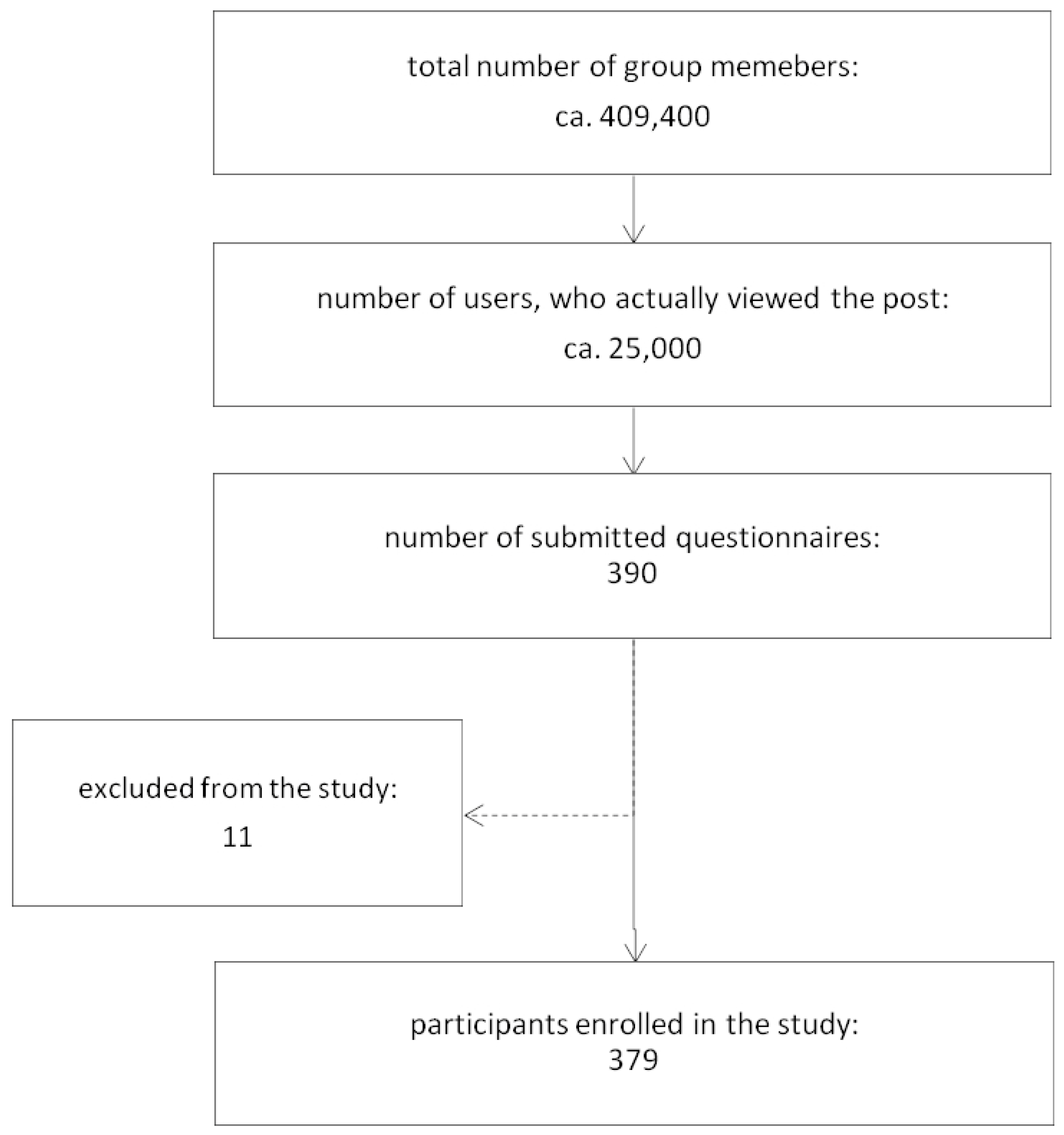
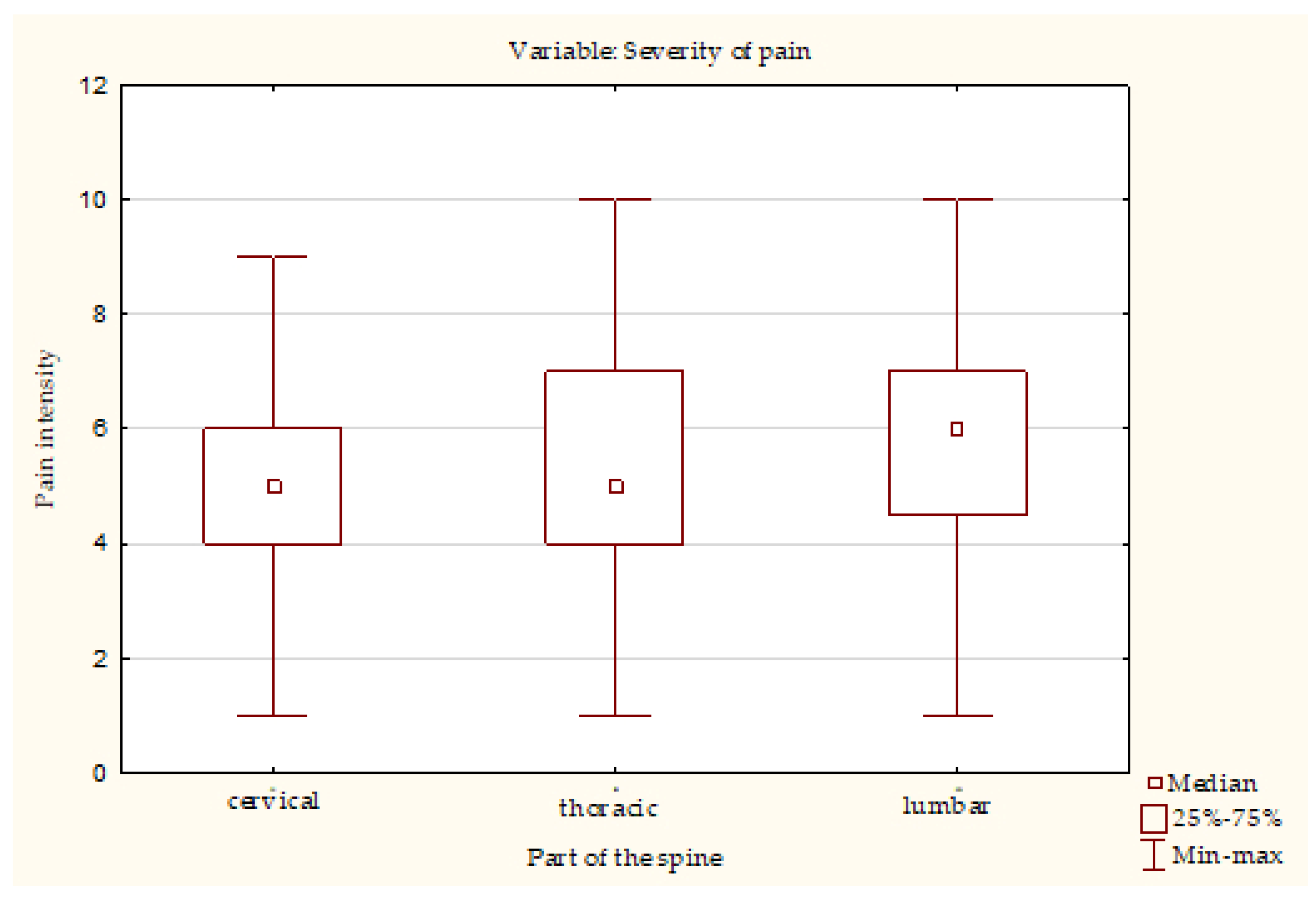
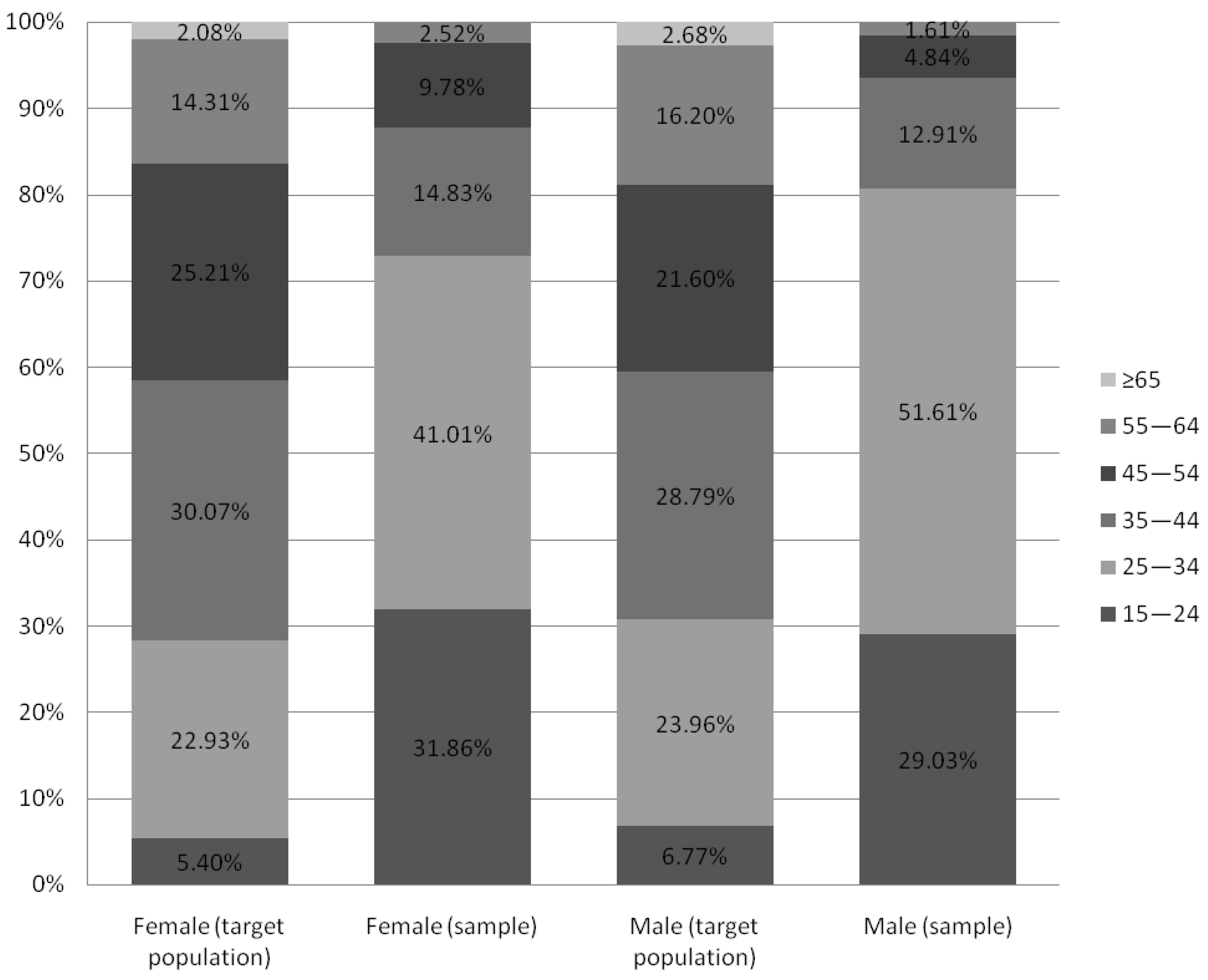
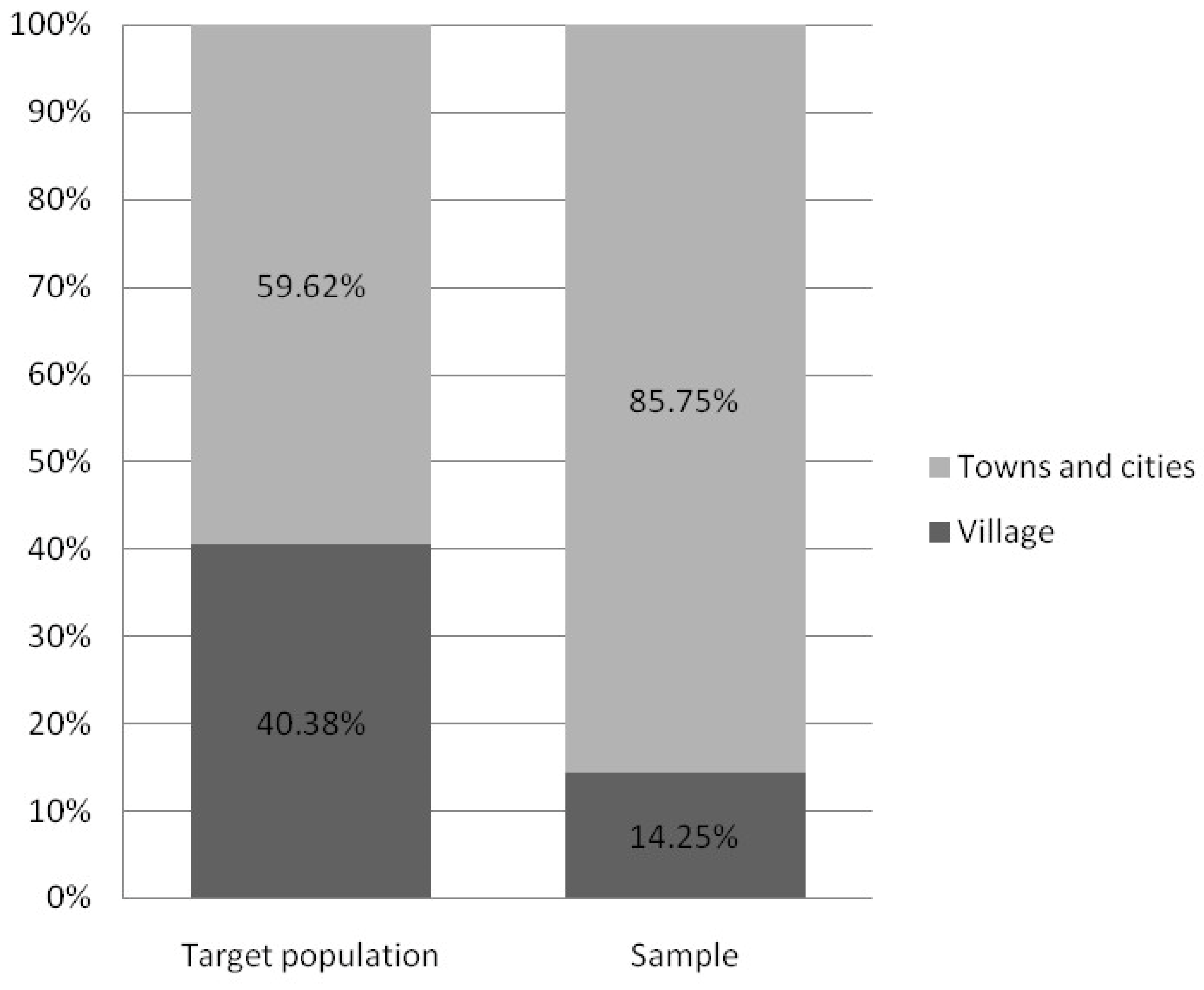
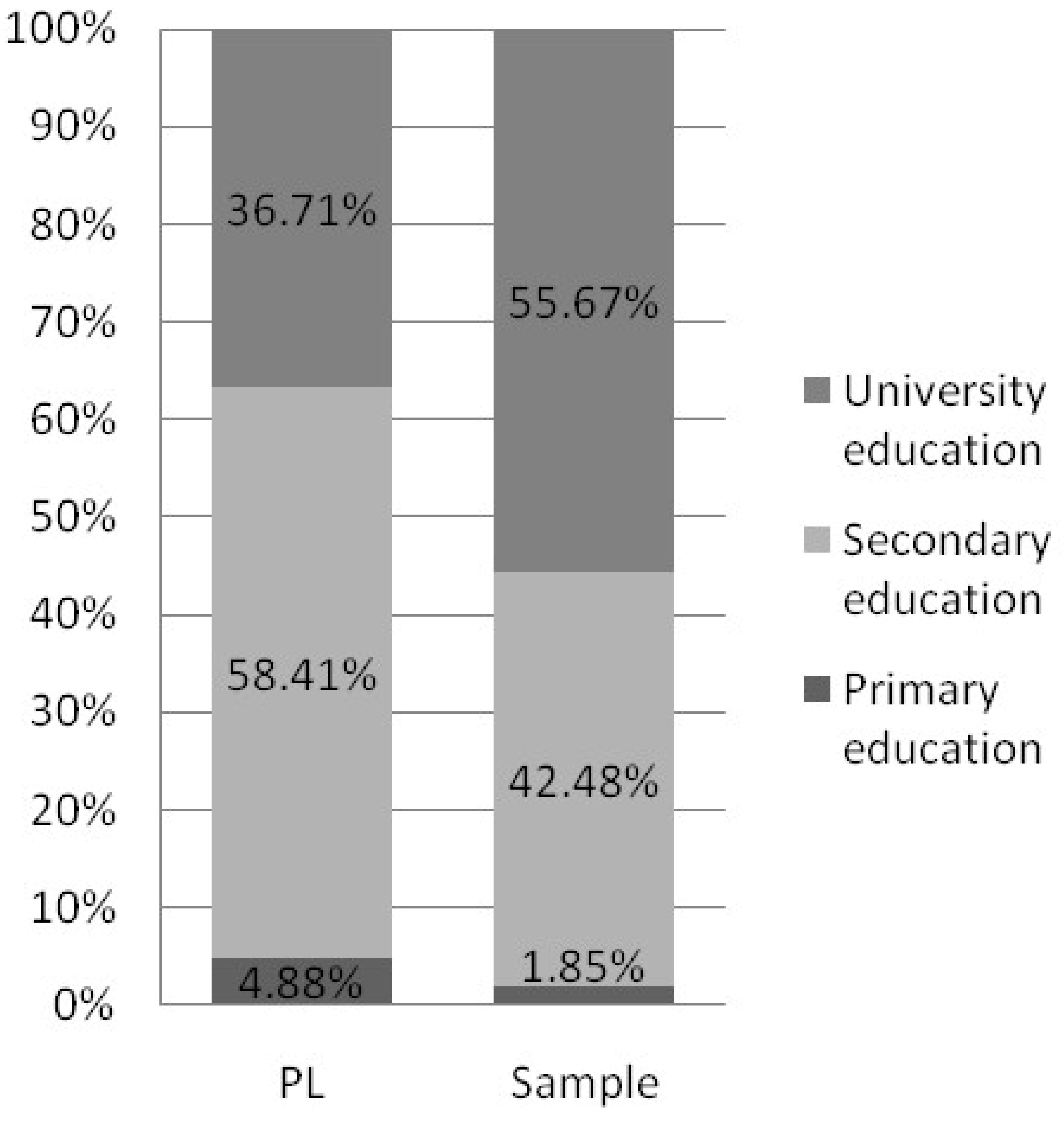
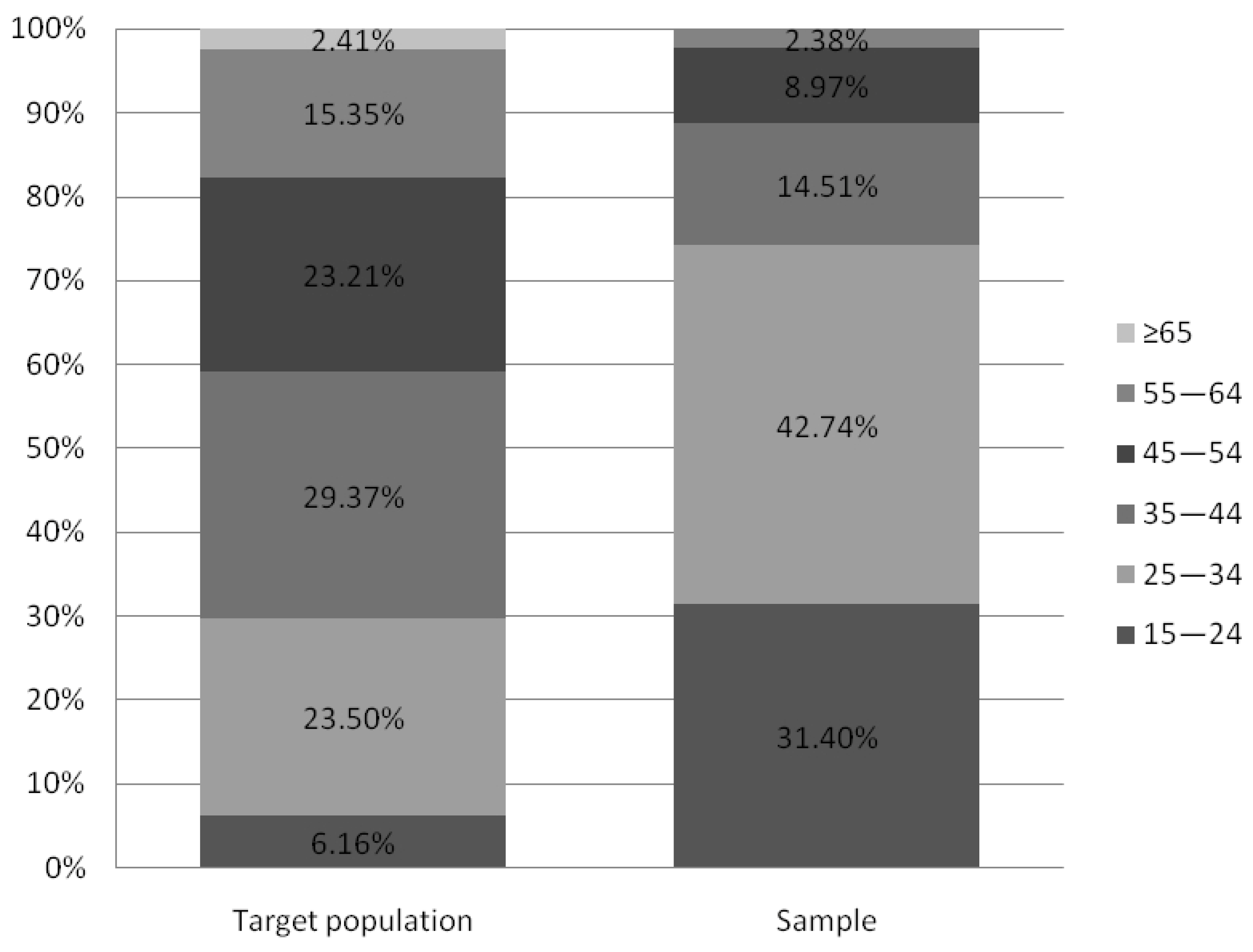

| Baseline Characteristic | Sedentary Work | Work in a Standing Position | Physical Work | Work in a Forced Position | Work That Requires Activity | All Professions | ||||||
|---|---|---|---|---|---|---|---|---|---|---|---|---|
| N = 213 | N = 29 | N = 49 | N = 47 | N = 41 | N = 379 | |||||||
| N | % | N | % | N | % | N | % | N | % | N | % | |
| Sex | ||||||||||||
| Female | 175 | 82.16 | 27 | 93.10 | 38 | 77.55 | 40 | 85.11 | 37 | 90.24 | 317 | 83.64 |
| Male | 38 | 17.84 | 2 | 6.90 | 11 | 22.45 | 7 | 14.89 | 4 | 9.76 | 62 | 16.36 |
| Age | ||||||||||||
| <25 years | 57 | 26.76 | 14 | 48.28 | 18 | 36.73 | 10 | 21.28 | 20 | 48.78 | 119 | 31.40 |
| 25–34 years | 101 | 47.42 | 12 | 41.38 | 16 | 32.65 | 22 | 46.81 | 11 | 26.83 | 162 | 42.74 |
| 35–44 years | 34 | 15.96 | 1 | 3.45 | 7 | 14.29 | 9 | 19.15 | 4 | 9.76 | 55 | 14.51 |
| 45–54 years | 17 | 7.98 | 1 | 3.45 | 5 | 10.20 | 5 | 10.64 | 6 | 14.63 | 34 | 8.97 |
| 55+ years | 4 | 1.88 | 1 | 3.45 | 3 | 6.12 | 1 | 2.13 | 0 | 0.00 | 9 | 2.37 |
| Education | ||||||||||||
| Primary education | 3 | 1.41 | 1 | 3.45 | 0 | 0.00 | 0 | 0.00 | 0 | 0.00 | 4 | 1.06 |
| Lower secondary education | 1 | 0.47 | 2 | 6.90 | 0 | 0.00 | 0 | 0.00 | 0 | 0.00 | 3 | 0.79 |
| Secondary education | 34 | 15.96 | 8 | 27.59 | 27 | 55.10 | 8 | 17.02 | 8 | 19.51 | 85 | 22.43 |
| University education | 134 | 62.91 | 8 | 27.59 | 18 | 36.73 | 38 | 80.85 | 13 | 31.71 | 211 | 55.67 |
| University student | 41 | 19.25 | 10 | 34.48 | 4 | 8.16 | 1 | 2.13 | 20 | 48.78 | 76 | 20.05 |
| Place of residence | ||||||||||||
| Village | 27 | 12.68 | 6 | 20.69 | 8 | 16.33 | 6 | 12.77 | 7 | 17.07 | 54 | 14.25 |
| Town inhabited by 10,000–100,000 people | 45 | 21.13 | 2 | 6.90 | 16 | 32.65 | 8 | 17.02 | 7 | 17.07 | 78 | 20.58 |
| City more than 100,000 people | 141 | 66.20 | 21 | 72.41 | 25 | 51.02 | 33 | 70.21 | 27 | 65.85 | 247 | 65.17 |
| Symptoms | Work in a Standing Position | Sedentary Work | Physical Work | Work That Requires Activity | Work in a Forced Position | All Professions | ||||||||||||||||||
|---|---|---|---|---|---|---|---|---|---|---|---|---|---|---|---|---|---|---|---|---|---|---|---|---|
| Frequency | Intensity | Frequency | Intensity | Frequency | Intensity | Frequency | Intensity | Frequency | Intensity | Frequency | Intensity | |||||||||||||
| n | % | SD | n | % | SD | n | % | SD | n | % | SD | n | % | SD | n | % | SD | |||||||
| Cervical pain | 18 | 62.07 | 5.11 | 1.78 | 162 | 76.06 | 5.11 | 1.59 | 32 | 65.31 | 5.72 | 1.85 | 26 | 63.41 | 5.27 | 1.54 | 34 | 72.34 | 5.44 | 1.71 | 272 | 71.77 | 5.24 | 1.65 |
| Thoracic pain | 12 | 41.38 | 5.42 | 2.54 | 108 | 50.7 | 5.08 | 1.92 | 31 | 63.27 | 5.65 | 1.89 | 15 | 36.59 | 4.87 | 1.64 | 27 | 57.45 | 5.11 | 1.67 | 193 | 50.92 | 5.18 | 1.9 |
| Lumbar pain | 24 | 82.76 | 6.21 | 1.69 | 180 | 84.51 | 5.87 | 2.07 | 41 | 83.36 | 6.07 | 1.81 | 35 | 85.37 | 5.69 | 1.86 | 40 | 85.11 | 6.13 | 1.9 | 320 | 84.43 | 5.93 | 1.96 |
| Shoulder pain | 13 | 44.83 | 4.92 | 1.71 | 61 | 28.64 | 5.15 | 1.98 | 22 | 44.9 | 6.24 | 1.84 | 17 | 41.46 | 5.29 | 2.05 | 23 | 48.94 | 5.48 | 2.13 | 136 | 35.88 | 5.37 | 1.98 |
| Elbow pain | 2 | 6.9 | 6 | 2.83 | 32 | 15.02 | 5 | 1.76 | 10 | 20.41 | 5.2 | 1.62 | 3 | 7.32 | 4 | 0 | 10 | 21.28 | 4.9 | 1.6 | 57 | 15.04 | 5 | 1.67 |
| Hand joints pain | 13 | 44.83 | 5.15 | 2.3 | 112 | 52.58 | 4.85 | 1.97 | 29 | 59.18 | 5.24 | 1.75 | 15 | 36.59 | 4.67 | 2.09 | 27 | 57.45 | 4.78 | 2.03 | 196 | 51.72 | 4.9 | 1.97 |
| Hip pain | 5 | 17.24 | 5.4 | 1.52 | 54 | 25.35 | 5.21 | 1.97 | 18 | 36.73 | 5.67 | 2.03 | 12 | 29.27 | 4.67 | 1.83 | 13 | 27.66 | 5.58 | 2.43 | 102 | 26.91 | 5.28 | 1.99 |
| Knee pain | 7 | 24.14 | 5 | 1.73 | 46 | 21.6 | 4.72 | 2.1 | 24 | 49.98 | 5.13 | 2.01 | 22 | 53.66 | 4.32 | 1.59 | 14 | 29.79 | 5.64 | 2.37 | 113 | 29.82 | 4.86 | 2.01 |
| Ankle pain | 12 | 41.38 | 5.42 | 2.27 | 18 | 8.45 | 5.06 | 2.48 | 20 | 40.82 | 5.55 | 2.04 | 15 | 36.59 | 4.67 | 2.29 | 10 | 21.28 | 5.5 | 1.96 | 75 | 19.79 | 5.23 | 2.2 |
| Lower extremity paraesthesia | 10 | 34.48 | - | - | 90 | 42.25 | - | - | 16 | 32.65 | - | - | 20 | 48.78 | - | - | 20 | 42.55 | - | - | 156 | 41.16 | - | - |
| Heavy legs | 19 | 65.52 | - | - | 91 | 42.72 | - | - | 35 | 71.43 | - | - | 24 | 58.54 | - | - | 25 | 53.19 | - | - | 194 | 51.19 | - | - |
| Varices | 1 | 3.45 | - | - | 4 | 1.88 | - | - | 2 | 4.08 | - | - | 0 | 0 | - | - | 2 | 4.26 | - | - | 9 | 2.37 | - | - |
| Telangiectasia | 8 | 27.59 | - | - | 62 | 29.11 | - | - | 11 | 22.45 | - | - | 14 | 34.15 | - | - | 16 | 34.04 | - | - | 111 | 29.29 | - | - |
| Discolorations | 0 | 0 | - | - | 1 | 0.47 | - | - | 0 | 0 | - | - | 0 | 0 | - | - | 0 | 0 | - | - | 1 | 0.26 | - | - |
| Telangiectasia and varices | 0 | 0 | - | - | 15 | 7.04 | - | - | 4 | 8.16 | - | - | 0 | 0 | - | - | 2 | 4.26 | - | - | 21 | 5.54 | - | - |
| Telangiectasia and discolorations | 0 | 0 | - | - | 1 | 0.47 | - | - | 0 | 0 | - | - | 0 | 0 | - | - | 0 | 0 | - | - | 1 | 0.26 | - | - |
| Symptoms | Sex | Place of Residence | Education | Physical Activity | Type of Work | ||||||||||
|---|---|---|---|---|---|---|---|---|---|---|---|---|---|---|---|
| Pearson’s χ2 (df = 1) | Cramer’s V | Pearson’s C | Pearson’s χ2 (df = 2) | Cramer’s V | Pearson’s C | Pearson’s χ2 (df = 4) | Cramer’s V | Pearson’s C | Pearson’s χ2 (df = 6) | Cramer’s V | Pearson’s C | Pearson’s χ2 (df = 4) | Cramer’s V | Pearson’s C | |
| Neck pain | 1.16 | - | 0.06 | 1.57 | 0.06 | 0.06 | 7.40 | 0.14 | 0.14 | 3.92 | 0.10 | 0.10 | 5.71 | 0.12 | 0.12 |
| Upper-back pain | 0.51 | - | 0.04 | 8.07 * | 0.15 | 0.14 | 6.06 | 0.13 | 0.13 | 10.75 | 0.17 | 0.17 | 8.22 | 0.15 | 0.15 |
| Low back pain | 0.27 | - | 0.03 | 5.57 | 0.12 | 0.12 | 3.74 | 0.10 | 0.10 | 9.25 | 0.16 | 0.15 | 0.13 | 0.02 | 0.02 |
| Shoulder pain | 0.88 | - | 0.05 | 0.54 | 0.04 | 0.04 | 9.36 | 0.16 | 0.16 | 3.36 | 0.09 | 0.09 | 11.63 * | 0.18 | 0.17 |
| Elbow pain | 0.26 | - | 0.03 | 1.39 | 0.06 | 0.06 | 3.32 | 0.09 | 0.09 | 4.53 | 0.11 | 0.11 | 5.95 | 0.13 | 0.12 |
| Hand pain | 0.29 | - | 0.03 | 7.71 | 0.14 | 0.14 | 6.68 | 0.13 | 0.13 | 7.02 | 0.14 | 0.13 | 6.09 | 0.13 | 0.13 |
| Upper extremity paraesthesia | 0.46 | - | 0.03 | 2.38 | 0.08 | 0.08 | 8.50 | 0.15 | 0.15 | 5.09 | 0.12 | 0.12 | 12.23 * | 0.18 | 0.18 |
| Hip pain | 3.17 | - | 0.09 | 2.27 | 0.08 | 0.08 | 9.55 * | 0.16 | 0.16 | 11.94 | 0.18 | 0.17 | 4.17 | 0.10 | 0.10 |
| Knee pain | 0.02 | - | 0.01 | 1.12 | 0.05 | 0.05 | 16.59 ** | 0.21 | 0.20 | 8.42 | 0.15 | 0.15 | 27.06 ** | 0.27 | 0.26 |
| Ankle | 1.30 | - | 0.06 | 4.71 | 0.11 | 0.11 | 24.83 ** | 0.26 | 0.25 | 10.51 | 0.17 | 0.16 | 46.77 ** | 0.35 | 0.33 |
| Lower extremity paraesthesia | 0.18 | - | 0.02 | 1.03 | 0.05 | 0.05 | 1.41 | 0.06 | 0.06 | 13.37 * | 0.19 | 0.18 | 3.12 | 0.09 | 0.09 |
| Lower extremity paraesthesia (frequency) | 1.60 (df = 6) | 0.07 | 0.06 | - | - | - | - | - | - | 62.84 ** (df = 36) | 0.17 | 0.38 | 25.16 (df = 24) | 0.13 | 0.25 |
| Heavy legs | 10.63 ** | - | 0.17 | 6.09 * | 0.13 | 0.13 | 6.34 | 0.13 | 0.13 | 8.67 | 0.15 | 0.15 | 17.49 ** | 0.21 | 0.21 |
| Heavy legs (frequency) | 13.84 * (df = 6) | 0.19 | 0.19 | - | - | - | - | - | - | 50.20 (df = 36) | 0.15 | 0.34 | 43.02 ** (df = 24) | 0.17 | 0.32 |
| Other Lower extremity symptoms | 43.98 ** (df = 6) | 0.34 | 0.32 | 7.39 (df = 12) | 0.10 | 0.14 | 16.06 (df = 24) | 0.10 | 0.20 | 35.95 (df = 36) | 0.13 | 0.29 | 16.24 (df = 24) | 0.10 | 0.20 |
Disclaimer/Publisher’s Note: The statements, opinions and data contained in all publications are solely those of the individual author(s) and contributor(s) and not of MDPI and/or the editor(s). MDPI and/or the editor(s) disclaim responsibility for any injury to people or property resulting from any ideas, methods, instructions or products referred to in the content. |
© 2023 by the authors. Licensee MDPI, Basel, Switzerland. This article is an open access article distributed under the terms and conditions of the Creative Commons Attribution (CC BY) license (https://creativecommons.org/licenses/by/4.0/).
Share and Cite
Kliniec, K.; Mendowski, M.; Zuziak, P.; Sobieski, M.; Grata-Borkowska, U. The Correlation of Frequency of Work-Related Disorders with Type of Work among Polish Employees. Int. J. Environ. Res. Public Health 2023, 20, 1624. https://doi.org/10.3390/ijerph20021624
Kliniec K, Mendowski M, Zuziak P, Sobieski M, Grata-Borkowska U. The Correlation of Frequency of Work-Related Disorders with Type of Work among Polish Employees. International Journal of Environmental Research and Public Health. 2023; 20(2):1624. https://doi.org/10.3390/ijerph20021624
Chicago/Turabian StyleKliniec, Katarzyna, Mateusz Mendowski, Patrycja Zuziak, Mateusz Sobieski, and Urszula Grata-Borkowska. 2023. "The Correlation of Frequency of Work-Related Disorders with Type of Work among Polish Employees" International Journal of Environmental Research and Public Health 20, no. 2: 1624. https://doi.org/10.3390/ijerph20021624
APA StyleKliniec, K., Mendowski, M., Zuziak, P., Sobieski, M., & Grata-Borkowska, U. (2023). The Correlation of Frequency of Work-Related Disorders with Type of Work among Polish Employees. International Journal of Environmental Research and Public Health, 20(2), 1624. https://doi.org/10.3390/ijerph20021624






